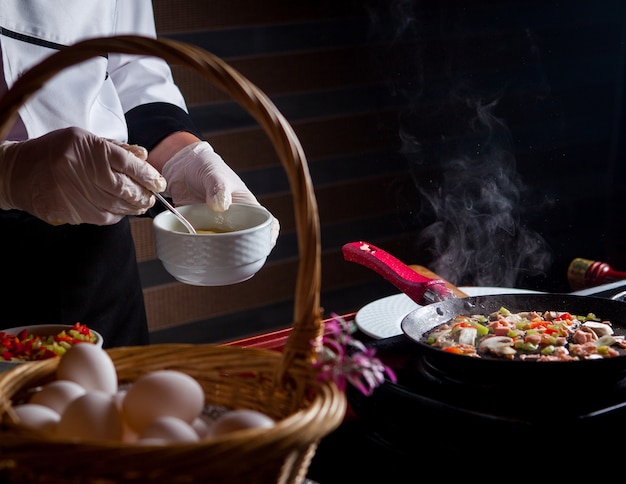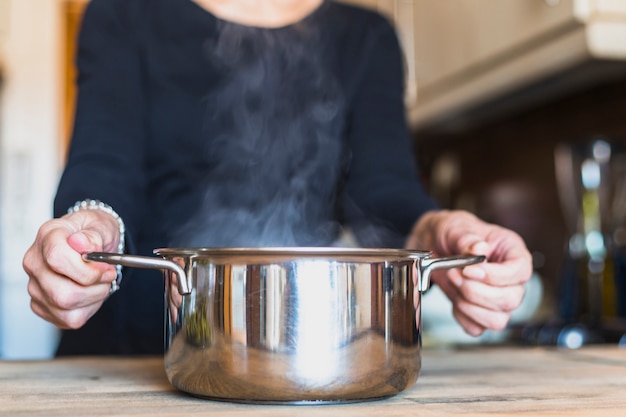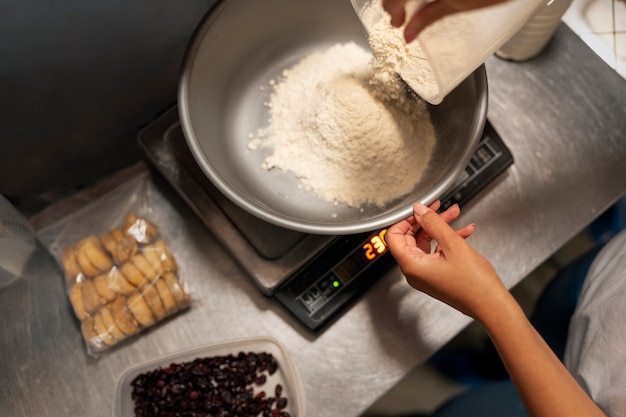You know the feeling: you've slaved over a hot stove, meticulously following a recipe, only to end up with a pot of rice that's either a sticky, gloopy mess or dry and crumbly. It's enough to make anyone crave a takeaway, right? But fear not, my fellow rice enthusiasts, because I'm here to share my tried-and-tested secrets to cooking perfect rice on the stovetop, every single time.
Over the years, I've experimented with countless rice recipes and techniques. I've had my fair share of rice disasters, but I’ve also discovered the little tricks that make all the difference. I’ve learned that mastering the art of stovetop rice is about more than just following a recipe; it's about understanding the fundamentals and having a bit of confidence in your kitchen skills.
So, grab your favourite pan, a measuring cup, and let's embark on this culinary journey together. By the time you're finished reading, you’ll be a rice-cooking maestro, ready to impress your friends and family with the most perfect fluffy and delicious rice.
(Part 1) Why Stovetop Rice is King

Before we dive into the nitty-gritty, let’s talk about why stovetop rice is the way to go. Yes, there are fancy rice cookers out there, but there’s just something so satisfying about cooking rice the old-fashioned way. You’ve got more control over the process, and you can really feel the love going into it.
Let me tell you, nothing beats the simple pleasure of watching those rice grains plump up beautifully as they cook. It's a little ritual, a quiet moment of zen in your kitchen.
Here's what I love about cooking rice on the stove:
- It's more versatile: You can experiment with different types of rice, from fluffy long-grain to sticky short-grain, and even wild rice. You can even try adding different flavourings and herbs. I love to toss in a handful of fresh parsley or cilantro for a vibrant flavour boost.
- It's cheaper: A rice cooker is an extra appliance that you might not even use that often. Stovetop rice is a budget-friendly option, especially when you're making large batches.
- It's fun: There's something undeniably satisfying about seeing the rice grains plump up beautifully as they cook. It’s a little ritual, a quiet moment of zen in your kitchen. It's a reminder that even the simplest of tasks can be a source of joy.
The Art of Choosing Rice
Just like wine, not all rice is created equal. Choosing the right type of rice is essential for achieving your desired texture and taste. So, before you start cooking, take a moment to consider the kind of rice you want to use.
Here’s a quick guide to some common types of rice:
| Rice Type | Characteristics | Best Uses |
|---|---|---|
| long-grain rice | Fluffy and separate grains, ideal for stir-fries and pilafs, as it holds its shape well. It also absorbs flavours beautifully, making it perfect for dishes like biryani. | Stir-fries, pilafs, fried rice, biryani |
| medium-grain rice | Slightly sticky, perfect for sushi and rice bowls, as it has a nice chewiness that makes it ideal for these dishes. It's also a great choice for rice salads as it doesn't become too mushy. | Sushi, rice bowls, some Asian dishes, rice salads |
| short-grain rice | Very sticky, great for rice pudding and mochi, as it creates a creamy and smooth texture. It's also a popular choice for sticky rice desserts and traditional Japanese dishes. | Rice pudding, mochi, sticky rice dishes, some Japanese dishes |
| Wild rice | Nutty flavour, chewy texture, takes longer to cook, as it has a more robust texture and flavour than other types of rice. It's a great addition to salads, soups, and side dishes. | Salads, soups, side dishes |
Once you’ve chosen your rice, give it a good rinse. This removes excess starch, which can lead to a sticky mess.
(Part 2) The Golden Ratio: Water to Rice

This is the real key to cooking perfect rice: getting the water-to-rice ratio just right. If you use too little water, your rice will be dry and crunchy. Too much water, and you’ll end up with a soggy, mushy mess.
The general rule of thumb is a 2:1 ratio of water to rice, meaning for every 1 cup of rice, you’ll use 2 cups of water. This ratio works well for most long-grain and medium-grain rice varieties.
But let’s face it, rules are made to be broken! Some rice varieties require a little more or less water. The key is to read the instructions on your rice bag carefully.
Here are a few tips for getting the water-to-rice ratio right:
- Use a measuring cup with a spout: This makes it easier to pour the water without spilling, ensuring you get the right amount of water.
- Don’t overfill the pot: Leave about an inch of space at the top of the pot to prevent the water from boiling over. This also allows for steam to circulate, which helps the rice cook evenly.
- Trust your intuition: If the rice seems a bit dry, add a little more water. If it seems too wet, you can always drain off some of the excess. Just remember, a little bit of practice goes a long way.
(Part 3) The Stovetop Ritual

Now that we’ve got the fundamentals down, let’s get to the actual cooking process.
Here’s what you’ll need:
- A medium-sized saucepan with a tight-fitting lid
- Your chosen rice (rinsed and ready to go)
- Water (2 cups for every 1 cup of rice)
- Salt (optional, but highly recommended)
Step 1: The First Boil
Pour the rice and water into the saucepan. Add a pinch of salt (about 1/4 teaspoon) if you like. Salt is optional, but it brings out the natural flavour of the rice, making it taste even better.
Bring the pot to a boil over high heat. You want to see bubbles bubbling up vigorously. Once the water is boiling, cover the pot with a tight-fitting lid.
Remember, the lid is crucial here. It traps the steam, which helps cook the rice evenly and keeps it from drying out.
Step 2: The Simmer
Now, it’s time to reduce the heat to a low simmer. You want the rice to cook slowly and evenly. Don’t peek! Let the rice do its thing for about 15 minutes.
I know it’s tempting to peek and check on the rice, but resist the urge. Peeking can let out steam and cause the rice to become dry. Patience is key in cooking perfect rice.
Step 3: The Rest
After 15 minutes, turn off the heat and let the rice rest for another 10 minutes, still covered. This is where the magic happens. The rice absorbs any remaining water, becoming fluffy and perfectly cooked.
This resting period is crucial for allowing the rice to achieve that perfect fluffy texture. It's like giving the rice a little time to relax and absorb the water, resulting in a delicious and satisfying meal.
(Part 4) Fluffing Up the Rice
Once the rice has rested for 10 minutes, you can finally unveil the masterpiece you’ve created. Use a fork to fluff the rice gently. This separates the grains, preventing them from sticking together.
If you’re feeling adventurous, you can add a knob of butter or a drizzle of olive oil to the rice while it’s still in the pot. This adds a touch of richness and flavour, and it's a simple way to elevate your rice game.
The rice is now ready to be served. Enjoy!
(Part 5) The Art of Timing
You might be thinking, “That’s all well and good, but what if I want to cook rice in advance?” Don’t worry, I’ve got you covered.
Cooking rice ahead of time is a great way to save time, especially when you’re preparing a big meal. The best way to do it is to follow the same steps as above, but let the rice rest for a longer period of time, up to 30 minutes.
Once the rice has rested, you can transfer it to a container and store it in the fridge for up to 3 days. To reheat the rice, simply microwave it on low power until it’s heated through.
However, keep in mind that cooked rice doesn't always reheat perfectly. It might lose a bit of its fluffiness, so if you're aiming for the best texture, it's always best to cook the rice fresh.
(Part 6) Rice Hacks
Over the years, I’ve discovered a few clever tricks that make cooking rice on the stove even easier and more foolproof.
Hack 1: The Cold Water Soak
Soaking the rice in cold water for 30 minutes before cooking can help it cook more evenly and prevent it from sticking together.
Just rinse the rice as usual, then cover it with cold water and let it soak for 30 minutes. Drain the rice before cooking as per the instructions above.
Soaking the rice helps the grains absorb water more evenly, leading to a more consistent texture. It's a great technique if you're using a rice variety that tends to stick.
Hack 2: The Aluminum Foil Lid
This is a little trick I learned from my grandmother. Instead of using the lid of the saucepan, cover the pot with a sheet of aluminum foil.
Aluminum foil creates a tight seal, preventing steam from escaping and ensuring the rice cooks evenly.
This hack is a great way to ensure the rice stays moist and cooks evenly. It's a particularly useful technique if you're cooking rice in a pot that doesn't have a perfectly tight-fitting lid.
Hack 3: The Rice Cooker Method
This hack is especially useful if you’re trying to cook rice for a large group. You can use your rice cooker to cook the rice, but then transfer it to a saucepan to rest and absorb any remaining water.
This method gives you the best of both worlds: the convenience of a rice cooker and the fluffy texture of stovetop rice.
This is a great compromise if you want the convenience of a rice cooker but still desire that perfect fluffy texture. It allows the rice to finish cooking and absorb any remaining moisture for optimal results.
(Part 7) Beyond Plain Rice
Now that you’ve mastered the art of cooking perfect white rice, it’s time to experiment with different flavours and variations.
Here are a few ideas to get you started:
1. Herbed Rice
Add a handful of fresh herbs, like parsley, cilantro, or dill, to the rice while it's cooking.
Herbs add a burst of freshness and flavour to rice, and they're so easy to incorporate. You can also use dried herbs, but fresh herbs offer a more vibrant flavour.
2. Citrus Rice
Add a squeeze of lemon or lime juice to the rice during the simmering stage. This adds a bright, tangy flavour.
Citrus juice is a great way to add a touch of acidity and brightness to rice, especially if you're pairing it with rich or savory dishes.
3. Spiced Rice
Add a pinch of ground cumin, coriander, or turmeric to the rice for a warm, aromatic flavour.
Spices add a depth of flavour and complexity to rice. You can experiment with different spice combinations to create unique flavour profiles.
4. Mushroom Rice
Sauté some chopped mushrooms in butter or olive oil before adding the rice and water. This creates a flavourful and satisfying rice dish.
Mushrooms add a savory and umami flavour to rice, making it a delicious and satisfying side dish. You can use any type of mushroom you like, but I recommend using a mix of cremini and shiitake mushrooms for a more complex flavour.
(Part 8) Rice and Beyond
Rice is incredibly versatile, and it can be used in countless ways. From simple side dishes to elaborate main courses, rice is a culinary chameleon that can adapt to any flavour profile.
Here are a few of my favourite ways to use rice:
- As a base for stir-fries and fried rice: Rice provides a fluffy and neutral canvas for bold Asian flavours.
- In rice bowls: Combine cooked rice with your favourite proteins, vegetables, and sauces for a satisfying and healthy meal.
- As a filling for stuffed peppers and vegetables: Rice adds a comforting and hearty element to these dishes.
- As a side dish for curries and stews: Rice is a classic companion for spicy and savory dishes.
- In rice pudding: A sweet and creamy dessert that is perfect for a cold evening.
FAQs
Here are some frequently asked questions about cooking rice on the stovetop:
1. What if my rice is still crunchy after 15 minutes of simmering?
If your rice is still crunchy, it likely needs a bit more time to cook. Add a splash of water to the pot, cover it, and simmer for a few more minutes.
Don't worry, this is a common occurrence. Just add a little more water and give it a few more minutes. The goal is to achieve a soft and tender texture, not a hard and crunchy one.
2. What if my rice is mushy?
If your rice is mushy, it might have been cooked for too long. You can try fluffing the rice and letting it dry out for a few minutes. If it’s still too wet, you can drain off some of the excess water.
Mushy rice is a bit of a bummer, but it's easily remedied. Fluffing the rice and letting it dry out can help, and sometimes draining off some excess water can do the trick. Remember, it's all about adjusting the cooking process until you achieve the desired texture.
3. Can I cook rice in the oven?
Yes, you can cook rice in the oven. Pre-heat the oven to 350 degrees fahrenheit (175 degrees Celsius). Combine the rice, water, and salt in an oven-safe dish. Cover the dish with aluminum foil and bake for 30-40 minutes, or until the rice is cooked through.
Cooking rice in the oven is a great option if you're making a large batch or if you want to cook the rice alongside other dishes. Just make sure to use an oven-safe dish and cover it with aluminum foil to ensure the rice cooks evenly.
4. How can I prevent rice from sticking to the bottom of the pot?
Use a non-stick saucepan or add a tablespoon of oil to the pot before adding the rice.
Sticking rice can be a real pain, but a non-stick saucepan or a bit of oil can prevent it. Just be sure to use a heat-resistant oil, like olive oil or avocado oil, so it doesn't smoke or burn.
5. Can I use brown rice instead of white rice?
Yes, you can cook brown rice on the stovetop. The cooking time will be longer, around 45 minutes. You may also need to adjust the water-to-rice ratio slightly.
Brown rice is a healthier alternative to white rice, and it's just as easy to cook on the stovetop. Just be prepared for a longer cooking time and a slightly different texture. Brown rice has a chewier texture than white rice, but it's still delicious and versatile.
Everyone is watching

How to Cook Frozen Lobster Tails Perfectly: A Step-by-Step Guide
RecipesLobster. Just the word conjures up images of lavish meals, special occasions, and a taste of luxury. But let's...

Pigs in a Blanket Cooking Time: How Long to Bake for Perfect Results
RecipesAh, pigs in a blanket. Just the name conjures up images of those delightful little parcels of crispy pastry en...

Pork Fillet Cooking Time: How Long to Cook It Perfectly
RecipesPork fillet, or tenderloin as it's sometimes called, is a real favourite in our house. It's so versatile, and...

The Ultimate Guide to Tender, Juicy Pulled Pork
RecipesRight, let's talk pulled pork. It's one of those dishes that just screams "comfort food," doesn't it? I mean...

The Ultimate Guide to Cooking Delicious Frankfurters
RecipesLet's face it, we all love a good frankfurter. It's a classic, simple, and always satisfying. But let's be rea...
